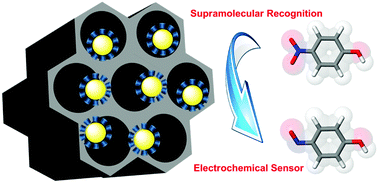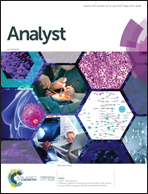An electrochemical sensor for the detection of p-nitrophenol based on a cyclodextrin-decorated gold nanoparticle–mesoporous carbon hybrid†
Abstract
In this work, a novel electrochemical sensor was constructed for the detection of p-nitrophenol. First, per-6-deoxy-per-6-(2-carboxy-methyl)thio-β-cyclodextrin (AcSCD) was synthesized and used as a stabilizer agent to decorate gold nanoparticles (AcSCD-AuNPs). Subsequently, a novel electrode material was fabricated by the incorporation of AcSCD-AuNPs on mesoporous carbon (MC). Furthermore, a glassy carbon electrode electrochemical sensor modified with AcSCD-AuNPs-MC was prepared and characterized by cyclic voltammetry (CV) and electrochemical impedance spectroscopy (EIS). Eventually, the constructed electrochemical sensor was used for the detection of p-nitrophenol by differential pulse voltammetry (DPV) experiments. The results showed that the linear response ranges are 0.1–10 μM and 10–350 μM, with a detection limit of 3.63 μg mL−1. Therefore, it is demonstrated that AcSCD-AuNPs-MC provides a synergistic effect of high catalytic activity from AuNPs and supramolecular recognition property from AcSCD effectively incorporated on MC for further electrochemical sensor applications.



 Please wait while we load your content...
Please wait while we load your content...